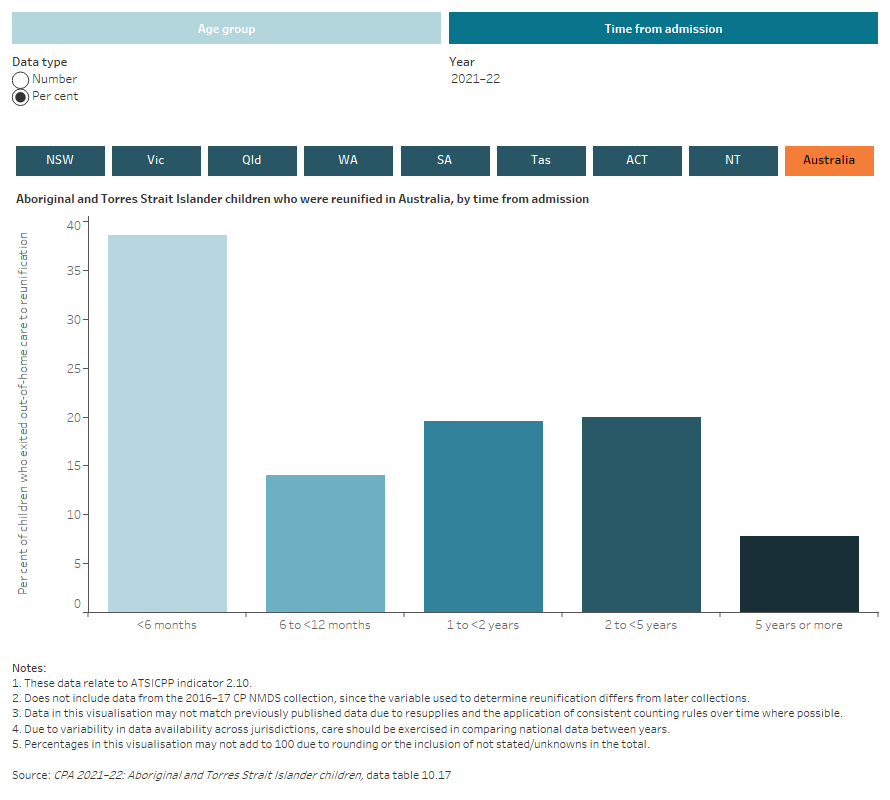Pathways from out-of-home care for Aboriginal and Torres Strait Islander children
There are multiple paths a child in out-of-home care (as per the nationally consistent definition of out-of-home care) can move through when transitioning from out-of-home care. These pathways from out-of-home care include children who are being:
- reunified with their families
- placed in a third-party care arrangement
- adopted from care
- aged-out of care once they turn 18 years old
- transitioned to other placements that are out-of-scope for out-of-home care (for example, a non-funded placement where they live independently).
Refer to the Glossary for more information on the different pathways from out-of-home care.
States and territories have committed to the safe reunification of children with families as part of the broader commitment to the implementation of the Aboriginal and Torres Strait Islander Child Placement Principle (ATSICPP) (DSS 2022; AIHW 2022).
Reunification is covered by the connection element of the ATSICPP (AIHW 2022). Reunifying Aboriginal and Torres Strait Islander children in out-of-home care with their families can mean potentially re-establishing the closest possible connection to their family, community and culture (SNAICC 2017). Children are considered to be eligible for reunification if they are in out-of-home care.
Considerations for pathways from out-of-home care
The different jurisdictional policies and practice can affect the comparability of pathways data, including:
- There is no nationally agreed definition for reunifications. As such, reporting of permanency events relating to reunification is based on local definitions of reunification.
- Third-party parental responsibility orders vary across jurisdictions with the biggest difference relating to the provision of ongoing case management in some cases.
Refer to the Appendices for more information on differences in jurisdictions’ policy and practice.
How many Aboriginal and Torres Strait Islander children were discharged from out-of-home care?
In 2021–22, about 4,200 Aboriginal and Torres Strait Islander children were discharged from out-of-home care. Of these children:
- 29% (1,200) were in out-of-home care for less than 6 months
- 28% (1,100) were in out-of-home care for 5 years or more.
Source: CPA 2021–22: Aboriginal and Torres Strait Islander children, data table 10.12.
The number of Aboriginal and Torres Strait Islander children discharged from out-of-home care increased with age, ranging from around 195 for those aged under one to about 1,500 for those aged 15–17 years.
Source: CPA 2021–22: Insights, data table S5.2.
Types of pathways from out-of-home care
For Aboriginal and Torres Strait Islander children discharged from out-of-home care in 2021–22:
- 40% (1,700) were reunified
- 8.7% (365) were placed on third-party orders
- 5 children were adopted
- 18% (730) aged-out
- 33% (1,400) included but are not limited to those that were transitioned to out-of-scope placements (Figure 7).
Source: CPA 2021–22: Aboriginal and Torres Strait Islander children, data table 10.13.
Figure 7: Aboriginal and Torres Strait Islander children who were discharged from out-of-home care, by exit pathway
This interactive data visualisation shows the number of Aboriginal and Torres Strait Islander children who were discharged from out-of-home care in the reporting period, by exit pathway. Data are displayed for each state and territory and Australia.

The ATSICPP states that reunification of children must be considered early, and plans and culturally safe supports must be put in place to support reunification where it is identified as possible (SNAICC 2017). Of the 1,700 Aboriginal and Torres Strait Islander children who were reunified in 2021–22:
- 92% (1,600) were reunified with birth parents
- 39% (650) were reunified within 6 months, followed by 20% (335) of children who were reunified between 2 to less than 5 years
- 29% (490) were aged one to four, compared with 6.7% (115) who were aged 16–17 years (Figure 8).
Sources: CPA 2021–22: Aboriginal and Torres Strait Islander children, data tables 10.14, 10.17 and 10.18.
Figure 8: Aboriginal and Torres Strait Islander children who exited out-of-home care to reunification
This interactive data visualisation shows the number of Aboriginal and Torres Strait Islander children who were reunified in 2017–18 to 2021–22, by age group and time from admission. Data are displayed for each state and territory and Australia.

Around 1,700 Aboriginal and Torres Strait Islander children aged 0–16 years were reunified in 2020–21. Of these, 83% (1,400) did not return to out-of-home care within 12 months of reunification (Figure 9).
Source: CPA 2021–22: Aboriginal and Torres Strait Islander children, data table 10.19.
Figure 9: Aboriginal and Torres Strait Islander children who exited out-of-home care to reunification, by whether they returned to out-of-home care within 12 months
This interactive data visualisation shows the number of Aboriginal and Torres Strait Islander children who exited out-of-home care to reunification in 2016–17 to 2020–21, by whether they returned to out-of-home care within 12 months. Data are displayed for each state and territory and Australia.

AIHW (2022) The Aboriginal and Torres Strait Islander Child Placement Principle indicators, AIHW, Australian Government, accessed 26 August 2022.
DSS (2022) Safe and Supported: Aboriginal and Torres Strait Islander First Action Plan 2023-2026, DSS, accessed 4 October 2023.
SNAICC – National Voice for our Children (2017) Understanding and applying the Aboriginal and Torres Strait Islander Child Placement Principle: a resource for legislation, policy, and program development, SNAICC, accessed 1 June 2023.
SNAICC – National Voice for our Children (2019), The Aboriginal and Torres Strait Islander Child Placement Principle: A guide to support implementation, SNAICC, accessed 1 June 2023.


